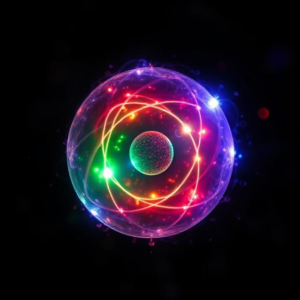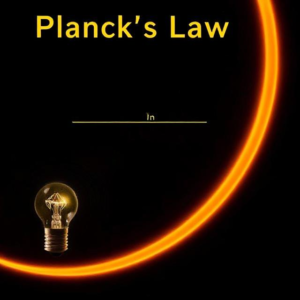Hydrogen Atom Spectrum and Bohr’s Theory:
What is the Hydrogen Atom Spectrum?
The hydrogen atom spectrum refers to the different colors or wavelengths of light that hydrogen atoms emit or absorb when their electrons move between different energy levels.

When hydrogen gas is heated or energized (like in a gas discharge tube), the electrons inside the hydrogen atoms get excited and jump to higher energy levels. But these higher energy levels are unstable. So, the electrons eventually fall back down to lower energy levels, and in doing so, they release energy in the form of light.
This light is emitted in specific wavelengths, and when we observe it, we see a pattern of lines called a spectrum. These lines represent the energy differences between the different energy levels of the electron.
Key Points:
- The spectrum of hydrogen is a series of bright lines of specific colors.
- These lines occur because the electron in the hydrogen atom can only exist in specific energy levels. When it jumps from one level to another, it releases light of a specific energy (and hence a specific color).
Types of Spectra:
- Emission Spectrum: When an atom emits light (like in a neon sign), we get bright lines at certain wavelengths.
- Absorption Spectrum: When light passes through a substance, it may absorb specific wavelengths, leaving dark lines in the spectrum.
Bohr’s Theory of the Hydrogen Atom
Niels Bohr was a scientist who proposed a theory to explain why the hydrogen atom spectrum had specific lines. Before Bohr, scientists didn’t fully understand how atoms worked, but Bohr’s model explained the hydrogen atom in a simple way.
Bohr’s Key Ideas:
- Electron Orbits:
- Bohr suggested that electrons move around the nucleus of the hydrogen atom in specific, fixed orbits (or energy levels). These orbits are like steps on a ladder. The electron can only exist in these orbits and cannot be in between them.
- These orbits are called quantized because the electron’s energy is restricted to certain discrete levels.
- Energy Levels:
- Each orbit corresponds to a specific energy level. The electron in the lowest orbit (the one closest to the nucleus) has the lowest energy. The farther the orbit from the nucleus, the higher the energy.
- These energy levels are numbered:
where
is the closest orbit to the nucleus.
- Electron Transitions:
- Electrons can jump from one orbit to another. When an electron jumps from a higher energy orbit to a lower energy orbit, it releases energy in the form of light. The energy of this light corresponds to the difference in energy between the two orbits.
- When an electron jumps from a lower orbit to a higher one, it absorbs energy.
- Quantized Energy:
- The energy of the electron is quantized, meaning it can only take on certain specific values. This explains the discrete lines in the hydrogen spectrum — only specific wavelengths of light are emitted or absorbed because the electron can only move between certain energy levels.
Bohr’s Equation for Energy Levels:
Bohr’s theory gives us a way to calculate the energy of each orbit. The formula for the energy of an electron in a particular orbit
is:
Where:
is the energy of the electron in the
-th orbit.
is the ground state energy of the electron in the hydrogen atom.
is the energy level (an integer: 1, 2, 3, etc.).
This formula shows that the energy of an electron is negative (because the electron is bound to the nucleus), and as
increases, the energy becomes less negative (the electron gets farther from the nucleus and has higher energy).
Explaining the Hydrogen Spectrum with Bohr’s Theory
The spectrum of hydrogen is related to the electron’s movement between these energy levels. When the electron jumps from a higher orbit to a lower one, the energy difference is released as light.
The wavelength (color) of this light depends on the difference in energy between the two levels. The larger the energy difference, the shorter the wavelength (bluer the light). The smaller the energy difference, the longer the wavelength (redder the light).
Bohr’s Prediction for the Spectrum:
Bohr’s theory successfully predicted the wavelengths of light emitted by hydrogen when the electron falls from one energy level to another. These wavelengths form the hydrogen emission spectrum, which is a series of lines at specific colors.
The most famous set of lines is known as the Balmer series, which corresponds to transitions where the electron falls to the second energy level (n=2). These lines fall in the visible part of the spectrum and correspond to the colors we can see, like red, blue, and violet.
Summary of Bohr’s Theory and the Hydrogen Spectrum:
- Bohr’s Model:
- Electrons in a hydrogen atom move in specific orbits around the nucleus.
- The orbits have discrete energy levels, and electrons can jump between these levels.
- When an electron moves to a lower energy level, it emits light with a specific wavelength corresponding to the energy difference between the levels.
- Hydrogen Spectrum:
- The hydrogen atom spectrum consists of bright lines that correspond to the specific energy differences between the atom’s energy levels.
- These lines are quantized, meaning only certain wavelengths are seen, corresponding to specific electron transitions.
In Simple Terms:
- Hydrogen Atom Spectrum: When electrons in a hydrogen atom jump between different energy levels, they release light. This light shows up as a series of colored lines (spectrum).
- Bohr’s Theory: Bohr said that electrons move in fixed orbits around the nucleus, and when they jump from one orbit to another, they emit or absorb light at specific wavelengths. This explains the lines we see in the hydrogen spectrum.











